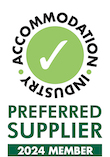How to Keep Allergies at Bay in Your Hotel
According to the Asthma and Allergy Foundation of America (AAFA), over 50 million allergic cases are reported in America each year, and allergic illnesses are among the rapidly growing chronic conditions in Australia.
As a hotel owner, being in control of allergens can improve your guest experience. Pollen, pet dander, dust mites, mould, and mildew spores could be causing allergic reactions in your guests.
Hotel bedding is a hotbed for dust mites, which are the most significant contributors to allergens. Allergy sufferers wake up feeling tired and itchy or have runny noses and start sneezing after sleeping in a hotel room with allergens.
To protect your guests from allergies, hotel owners should use ALS high-quality bed and bath linen that keeps allergies at bay in guest rooms.
10 Ways to Keep Allergies at Bay in Your Hotel
1. Use High-Quality Bed Linen
Hotel bedding is a hub for many allergens, like dust mites. ALS bed linen and products are hypoallergenic and can prevent dust mites from finding their way on to the guest's skin.
Dust mites are tiny insects that are invisible to the eyes. They feed on human skin flakes and are prevalent in mattresses, pillows, carpets, and bed covers.
Guests are always on the lookout for allergy-free rooms. You can exceed their expectations by protecting the bedding with dust-proof bed covers and pillow protectors from ALS that seal in any dust mites or allergies living inside the mattress.
When humans sleep, they sweat and shed about 1 gram of skin cells in a day. According to estimates, there are about ten million dust mites in a mattress, and 10% of the weight of your mattress is made up of dead skin and dust mites.
Removing this debris is not easy. That’s why it is vital to protect your hotel bedding and pillows with high-quality, allergen-proof linen to prevent allergen accumulation.
2. Ditch That Wall-to-Wall Carpet
Carpets are a favourite spot for allergens like dust mites, pollen, and pet dander. According to studies, there are more allergens in rooms with carpets than those without them.
Dust mites hide deep in carpets. Every day, they produce waste that is 200 times their body weight, which creates a lot of allergens. Even if you clean and sweep your carpet every time a guest leaves a hotel room, 95% of dust mites remain after vacuuming.
The Carpet and Rug Institute (CRI) states that carpets trap allergens and stop them from circulating in the air. While this is true, whenever guests sit or walk on that carpet, they send those allergens into the air. The allergens circulate in the air for several hours, which is more dangerous for people with allergies.
Ditching the carpets in your hotel rooms can significantly reduce the levels of dust mites. Opt for hard flooring like wood, vinyl, and tiles. They are much easier to clean and less favourable toward allergens.
3. Have Some Pet-Free Guest Rooms
Your guests would love to be accommodated together with their pets in your hotel. Have rooms that allow pet accommodation, especially service dogs and others that are pet-free.
However, cat and dog dander are a trigger for allergic reactions. Dead skin cells, saliva, urine, and other secretions from pets have proteins that are potential allergens.
Also, pet fur traps dust, pollen, and fleas which can become lodged in the carpet when pet hair sheds and lands on the carpet. Pet allergens are problematic, as they stick and cling to surfaces and can remain in a guest room for six months after the pet is gone.
It is crucial as a hotel owner to make some of your guests' rooms strictly pet-free so that no pet dander is present.
4. Use HEPA Filters
According to an EPA study, indoor air quality is two to three times more polluted than outdoor air.
You can improve the air quality in your guest rooms by using an air conditioner sporting HEPA technology. This air purifier removes allergens that are as small as 0.003 microns, which is better than the average air purifiers.
HEPA filters remove up to 99.7% of small particles from the air. This reduces airborne particles that cause allergies in guest rooms.
With air filters and air conditioning units, you don't have to open windows and exterior doors which allow pollen and dust to drift inside. Air conditioners also reduce humidity and inhibit the growth of mould and mildew.
5. No More Scented Cleaning Products
Many people with allergies are sensitive to scented products. Fragranced items like air fresheners, soap, hand sanitisers, and cleaning supplies cause allergic reactions like respiratory difficulties and headaches.
Asthma attacks and fragrance allergies that can cause itching, skin burning, and redness are frequent in hotels that use scented cleaning products. Keep allergies at bay in your hotel rooms by using fragrance-free cleaning products for your guests.
6. Forget About Flowers and Plants in Hotel Rooms
Beautiful flowers and plants make a guest room more elegant. However, any flowering plant inside a room has the potential to cause airborne allergens. Plants produce pollen, and when people with allergies inhale air with pollen, their symptoms may worsen.
Some people also get allergic reactions when they have direct contact with the plant. Leaving the soil too wet in the plant vase encourages the growth of mould, an additional allergen.
Do away with those plants and flowers in your guest's rooms to prevent allergies.
7. Dehumidify Hotel Rooms
The growth of mould and mildew in hotel rooms is a significant challenge that can give your guests bad allergies and earn you negative reviews. For mould to grow, there must be warm air, water, and food. All of these are present in your hotel rooms.
Many hotel owners link guests' comfort with achieving the required internal temperature and neglect humidity. If you cannot measure the moisture content in a room, you can't control the growth of mould.
According to the National Institute of Health, you need to maintain relative humidity below 50% to have effective control of dust mites and mould. All surfaces that collect standing water like bathrooms should be dried thoroughly.
Install hygrometers and humidistats to measure the humidity level in a room. Also have dehumidifying systems in place to remove moisture from the air.
8. Ditch the Heavy Curtains
Curtains complete the look of a guest room. Many hotel owners love using heavy curtains on guest rooms for their darkening ability. However, curtains are dust catchers and attract and trap a lot of allergens like dust mites.
Mould and mildew are attracted to moist surfaces like shower curtains. When guests inhale spores produced by mould, they may have allergic reactions.
Ditch the heavy curtains in your hotel rooms and opt for things like shutters and blinds that can be wiped clean to remove all dust necessary to keep allergens alive.
9. Cleanse and Sanitise Soft Surfaces
Allergens thrive on soft surfaces like sofa pillows, cushions, rugs, shelves, drapes, and furnishing. Such smooth surfaces should be cleaned and sprayed weekly to reduce airborne allergens.
Keeping your guest room clean can help control many indoor allergies. All materials and coatings that you cannot put in a washing machine should be steam cleaned. This will eliminate all contaminants that can trigger allergies.
10. Apply a Bacteriostatic Barrier
Hoteliers can apply a bacteriostatic barrier to all surfaces in the guest rooms to inhibit the growth of bacteria and germs. Colonisation of bacteria can exacerbate allergies. Shielding surfaces minimises the growth of bacteria and prevents microorganisms that trigger allergies.
Final Thoughts
Every hotelier's dream is to deliver the best guest experience and offer a restful night's sleep for all their guests. With allergens in your hotel, this dream may be a nightmare.
At ALS, we help hotel owners improve their guest experience with high-quality accommodation linen. To learn more about our products, contact us today.
Feature Image: Gary Bembridge















